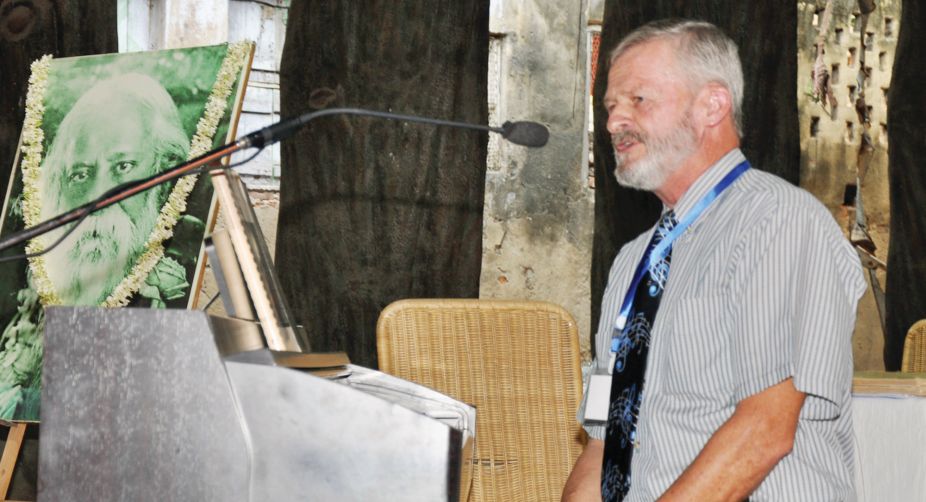Adnan Sami criticizes overuse of ‘ne’ in Punjabi songs
Singer Adnan Sami voices frustration over excessive use of 'Ne' in Punjabi music, sparking online debate. Details inside.
An international seminar at Rabindra Bharati University emphasised on the importance of nature and environment in the evolution of music over centuries.

Inauguration of the 2-day seminar.
It is an accepted fact that the source and destination of Indian music is nature, but the essence of this musical tradition is at stake in the present state of metropolitan confinement.
“The Impact of Nature and Environment on Music” was the topic of a two-day international seminar organised by the department of vocal music, Rabindra Bharati University at its Dwarakanath Mancha of Jorasanko Campus, Kolkata.
There were 12 different sub-themes of the main subject that aimed at making the students and scholars realise the importance of nature and environment in the process of evolution of music over centuries.
Advertisement
Papers and abstracts on these sub-themes were presented on both the days. Debasish Mondal, dean, faculty of fine arts, RBU inaugurated the seminar.
Goutam Nag, department of instrumental music, RBU delivered the keynote address. The other dignitaries who spoke on the main subject were Asit Ray, department of music, Rajshahi University, Bangladesh; Pt Anindya Banerjee, dean of academics, The Fifth Note (TFN), and John Thorpe, guest professor, department of music, Rajshahi University, Bangladesh. The latter also presented a piano recital.

Music recitals were interwoven with the seminar. The second day featured a vocal recital of vocalist Biplab Mukherjee, who sang khayal, tarana, thumri and bhajan, ably supported by Subhen Chatterjee’s tabla and Hiranmoy Mitra’s harmonium.
As the final artiste, renowned flautist Ronu Majumdar played raga Nageswarawali with gatkaris in rupak and teental. Young and brilliant tabla exponent Rohen Bose offered perceptible accompaniment. They concluded with a lilting Pahari dhun.
Harmonium’s ascend
1st April turned out to be a red letter day in the history of harmonium in India. On this day, Akashvani (Prasar Bharati) presented Hindustani classical harmonium solo recital in its prestigious Sunday National programme of music, featuring one of its erudite exponents Ravindra Gururaj Katoti.
Patented in France in 1840, harmonium reached India along with Parsi drama companies and soon emerged as a strong cultural bridge between the East and the West.
It became an integral part of musicals in rural as well as urban India. Harmonium’s universal presence in all socio, cultural and religious events in Indian subcontinent makes it an extremely significant instrument.
Almost all genres of music rely on harmonium’s steady support. And yet, during its early years, the puritan All India Radio officials did not allow the entry of harmonium on AIR because it cannot incorporate important musical nuances like meend and shrutis.
Between 1972 and 1974 a few Hindustani solo performances were broadcasted. Again after 1974 Hindustani Harmonium was restricted to only accompanying vocalists.
There were no grades for harmonium players belonging to Hindustani classical music. Interestingly harmonium solo performance and gradation in Karnataka music remained unhindered all these years; and ironically this was the time when Pandit Jnan Prakash Ghosh and his eminent disciples led by Pandit Ajoy Chakrabarty heavily relied on harmonium while teaching young aspirants, especially who came from musically uninitiated families.
Generations of erudite, creative and dedicated musicians became harmonium players and put their heart and soul together for the growth and evolution of harmonium’s playing techniques.
Stalwarts like Govindrao Tembe, Bhaiya Ganapatrao, Appa Jalagaokar, Jnanprakash Gosh, Munweshar Dayal, Maharaj banerjee, Sohanlal Sharma, Acharya Jayant Bose, Tulsidas Borkar, Manohar Chimote, Jyoti Goho, B Arunachalappa, Palladam Venkatramana Rao and several others have etched their unique style of harmonium playing essentially as very sensitive accompanists.
The present generation is more ambitious. The art of accompaniment opts for more dynamics now. For this youngsters like Rupashree Bhattacharya, Gourab Chatterjee, Paromita Mujherjee and several others take pains to learn dhrupad, khayal and thumri to incorporate the finer nuances of these diverse genres. Moreover, many are coming forward as soloists as well.
Recently Vishva Samvadini Shrunga was organised in Bangalore by Bijapure Harmoium Foundation to commemorate the birth centenary of the legendary harmonium exponent Pandit Rambhau Bijapure.
Eminent harmonium players such as Vishwanath Kanhere, Pramod Marathe, Aravind Thatte, Sudhanshu Kulkarni, Vidysdhar Oke, Vinay Mishra, Suvendu Banerjee and many others participated in first of its kind event. It was a live testimony to the huge pool of talent and creativity among harmonium soloists.

While so much is being done in this arena, AIR gradations kept harmonium at bay. In 1997 Hindustani harmonium players were given an opportunity for the gradation.
With persistence and perseverance Ravindra Gururaj Katoti, a prominent disciple of Pandit Rambhau Bijapure, could sail through the Music Audition Board of AIR in 2015 and became the first “A” graded artiste in Hindustani Harmonium category. In 2016 his solo recital was broadcast from AIR Dharwad. This broadcast received widest acclaim from musicians as well as connoisseurs.
After four long decades now, Prasar Bharati is projecting harmonium as a solo instrument in Hindustani music category in a big way. This is a welcome change by Prasar Bharati (Akashvani) that recognises this easily accessible, helpful and widely used, yet underrated musical instrument.
The broadcast of national music programme will take harmonium to widest group of listeners across the country and abroad. This step by Akashvani is sure to play a crucial role in establishing harmonium as a solo instrument as well.
Advertisement